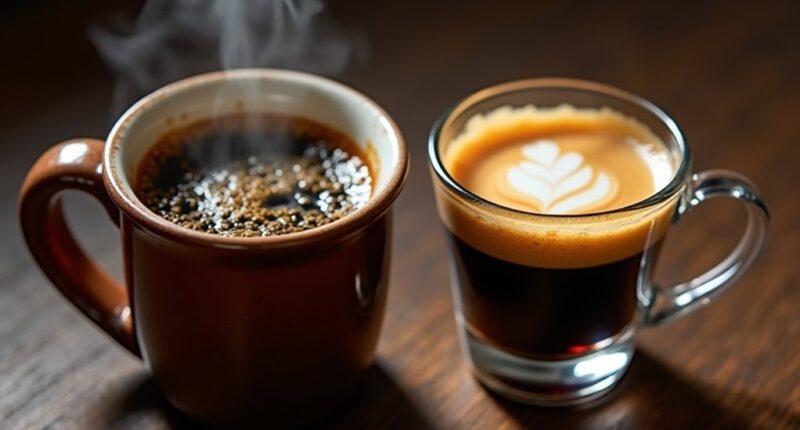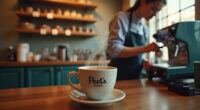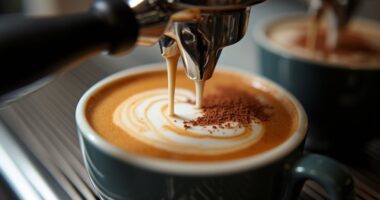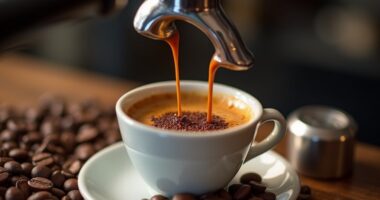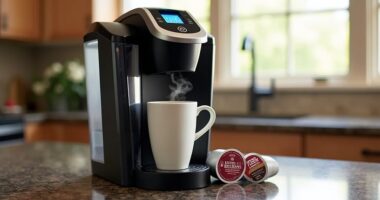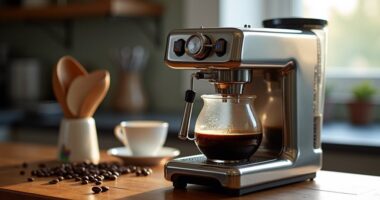So, what’s the scoop on black coffee and espresso? Well, espresso’s all about high pressure and quick shots, making it super concentrated and rich. Black coffee, on the other hand, takes time and allows those flavors to bloom in a slow, smooth brew. Espresso packs a caffeine punch in a tiny glass, while a big ol’ mug of black coffee has more caffeine overall. Each has its vibe, so pick your poison based on your mood—stick around, and you’ll uncover more fun facts!
At a Glance
- Espresso is brewed using high pressure, resulting in a concentrated shot, while black coffee is made through gravity or immersion methods.
- A single espresso shot is 1 oz with about 63 mg of caffeine, while an 8 oz black coffee contains approximately 95-96 mg.
- The flavor profile of espresso is bold and intense, whereas black coffee is milder and often smoother.
- Espresso features a thicker, syrupy texture and crema, while black coffee has a light-bodied nature.
- Cultural contexts influence preferences, with espresso favored for quick consumption and black coffee appealing to those seeking a milder experience.
Brewing Methods and Process Differences
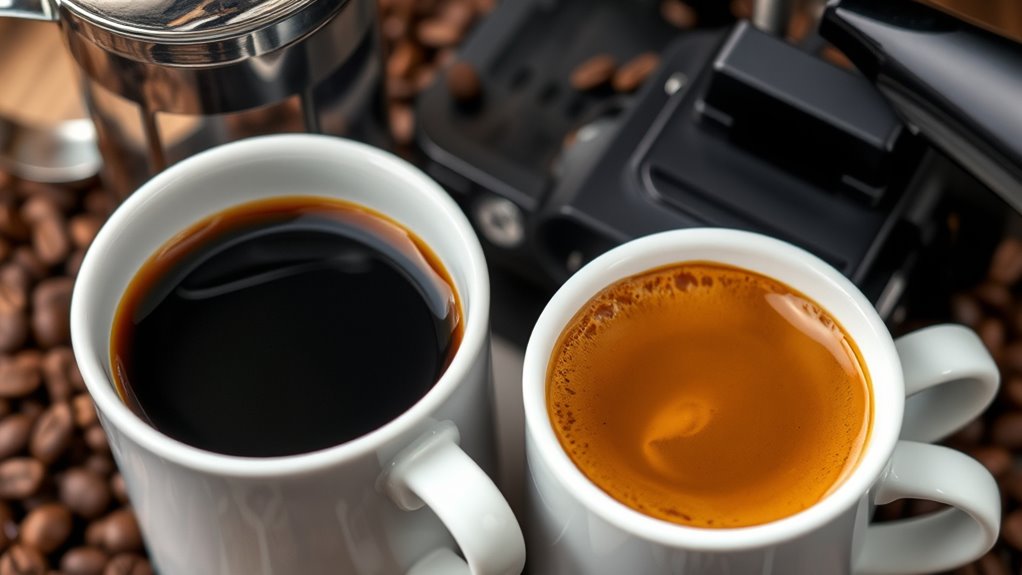
When you think about brewing coffee, it’s like comparing apples to oranges—both are delicious, but they’re totally different experiences!
Espresso’s all about high-pressure extraction methods, cranking out rich, concentrated shots in just 20-30 seconds. On the flip side, black coffee uses gravity or immersion, taking its sweet time—3 to 6 minutes—to create a lighter, cleaner brew.
You’ve got fancy espresso machines versus simple drip brewers or pour-overs. The quality of espresso can also be influenced by factors such as the perfect tamper, which helps ensure even extraction for the best flavor.
Grind Size and Roast Level
So, you’ve got your brewing methods down, and now it’s time to get into the nitty-gritty of grind size and roast level—two key players in the coffee game!
When you’re brewing black coffee, you’ve got grind types that range from coarse for French press to medium-fine for pour-overs. Each delivers its own flavor magic! It’s important to remember that a coarse grind is essential for French press coffee to prevent bitterness and ensure a smooth cup.
Now, let’s chat roast preferences. Light roasts are bright and fruity, while dark roasts bring that bold, smoky vibe.
Light roasts offer a bright, fruity taste, while dark roasts deliver a rich, bold smokiness.
There’s no strict rule, but medium roasts are the crowd-pleasers. Explore these options, and you’ll find your perfect cup that feels just right for you!
Caffeine Content and Serving Size
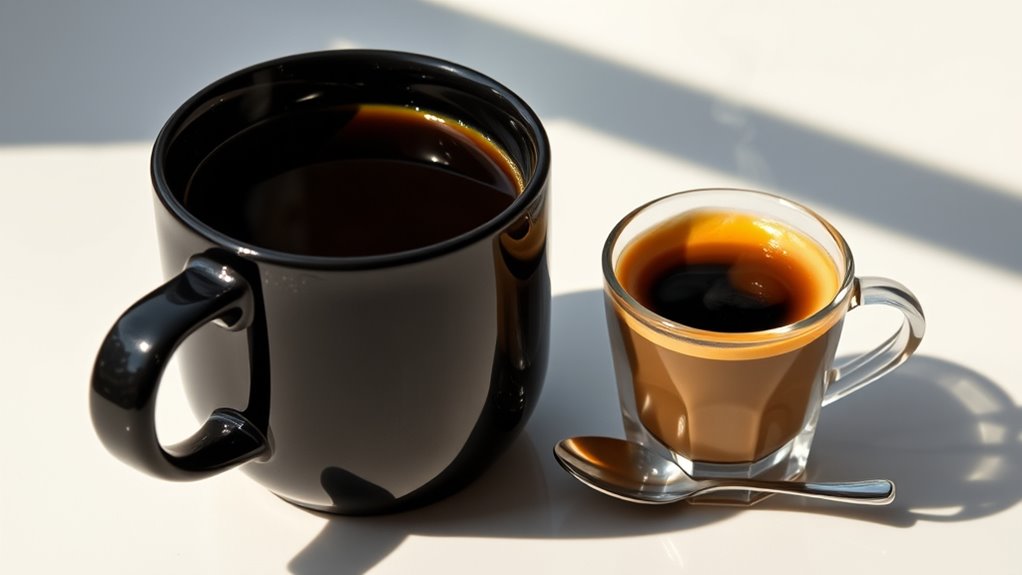
If you’ve ever wondered why that tiny shot of espresso packs such a punch, you’re not alone!
Here’s the scoop on caffeine concentration and serving preferences:
- A single espresso shot (1 oz) has about 63 mg of caffeine.
- An 8 oz cup of black coffee contains 95–96 mg.
- A double shot of espresso (2 oz) gives you 126 mg—almost like a big cup of coffee!
- Espresso is over 5 times more caffeine-dense than drip coffee.
Additionally, the rich flavors found in ground coffee can enhance your overall coffee experience, making the caffeine hit even more enjoyable.
Flavor Profile and Sensory Experience
While you might think all coffee is created equal, the flavor profile and sensory experience of black coffee and espresso can feel like two very different worlds. Espresso packs a punch with its bold flavor intensity, while black coffee offers a delightful aroma complexity that can vary widely. One key aspect to consider is that different coffee beans and preparation methods can significantly influence the overall experience, making it essential to discover your perfect black coffee blend.
Here’s a quick comparison:
| Aspect | Espresso | Black Coffee |
|---|---|---|
| Flavor Intensity | Bold and concentrated | Milder and nuanced |
| Aroma Complexity | Sweet, fruity, smoky | Origin-dependent |
| Texture | Thick and syrupy | Clean and light-bodied |
Cultural and Consumption Context
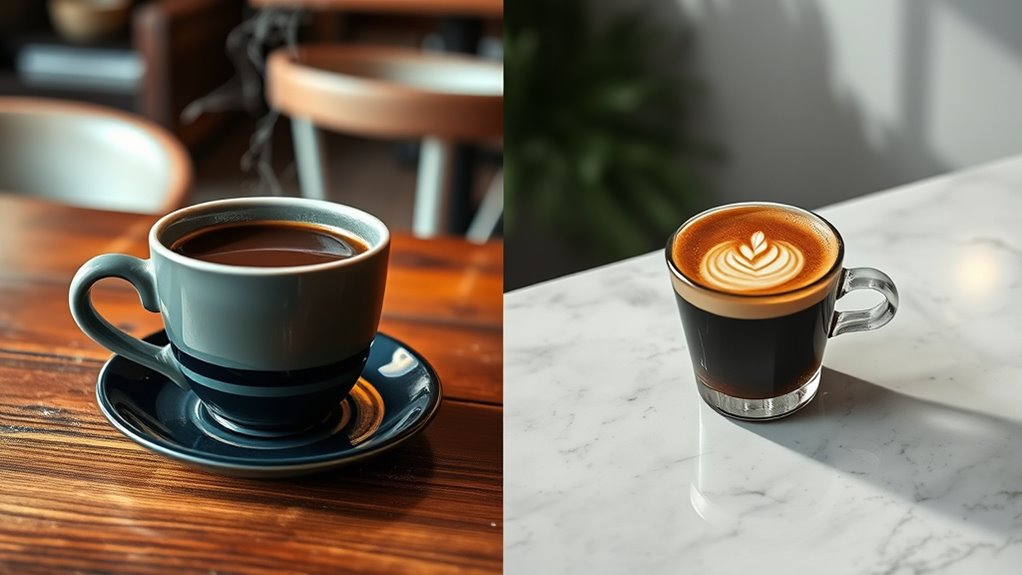
When you think about coffee, it’s not just about the drink itself; it’s also about the moments and cultures that come with it. The cultural significance of coffee runs deep, shaping consumption habits around the world.
Here are a few highlights:
- Ethiopian coffee ceremonies foster community and connection.
- In Italy, espresso is a quick morning ritual enjoyed at bustling cafés.
- Australia’s coffee scene thrives on espresso-based drinks like Flat Whites.
- Cuban Café Cubano is a sweet, creamy delight, perfect for social gatherings.
- In Costa Rica, the finest coffee is celebrated for its rich flavors and unique growing conditions, enhancing local traditions and coffee culture.
Equipment and Preparation Time
You might be surprised to learn that brewing black coffee and pulling a shot of espresso can feel like two different worlds, even though they both start with those magical coffee beans.
For black coffee, you’ve got options like pour-over or a trusty drip machine—easy-peasy! Just set it up, and let it brew.
Espresso, on the other hand, needs an espresso machine and some finesse. You’ll spend about 20–30 seconds per shot, but those fancy machines can do it all at the push of a button. The best drip coffee makers are designed to extract maximum flavor from the coffee grounds, enhancing your black coffee experience.
The Role of Pressure in Extraction
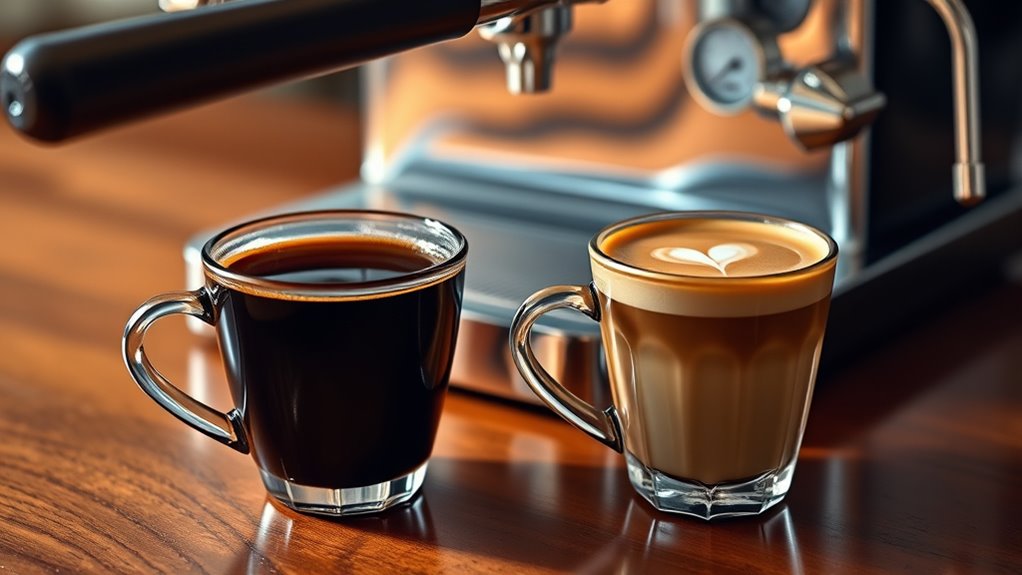
Brewing coffee isn’t just about the beans; it’s also about the magic of pressure that makes espresso so special.
Here’s how pressure impacts your cup:
- Pressure Range: Espresso machines typically use 9 bars, extracting rich flavors without bitterness.
- Extraction Time: High pressure means quick extraction, just 20-30 seconds!
- Flavor Profile: More pressure equals more oils, leading to a bolder taste.
- Crema Creation: That glorious foam on top? It’s all about pressure!
Additionally, the right automatic espresso machine can help achieve consistent results with every brew.
Serving Styles and Presentation
Serving coffee isn’t just about pouring it into a cup; it’s like setting the stage for a little caffeine drama!
Imagine this: espresso arrives in a tiny, elegant demitasse cup, all about quick sips and intense flavor. Meanwhile, your black coffee struts in a larger mug, ready for leisurely enjoyment.
Espresso dazzles in its petite cup for swift indulgence, while black coffee takes its time in a spacious mug.
Those presentation styles matter—espresso flaunts its golden crema, while black coffee’s clarity invites you to customize with cream or sugar. A well-chosen mug, particularly one with double-wall insulation, enhances the experience by keeping your beverage hot while remaining comfortable to hold.
Whether you’re standing at a bustling bar or relaxing with friends at brunch, these serving rituals create a cozy vibe, making every sip a moment to savor.
Cheers to that!
Popular Variations and Innovations
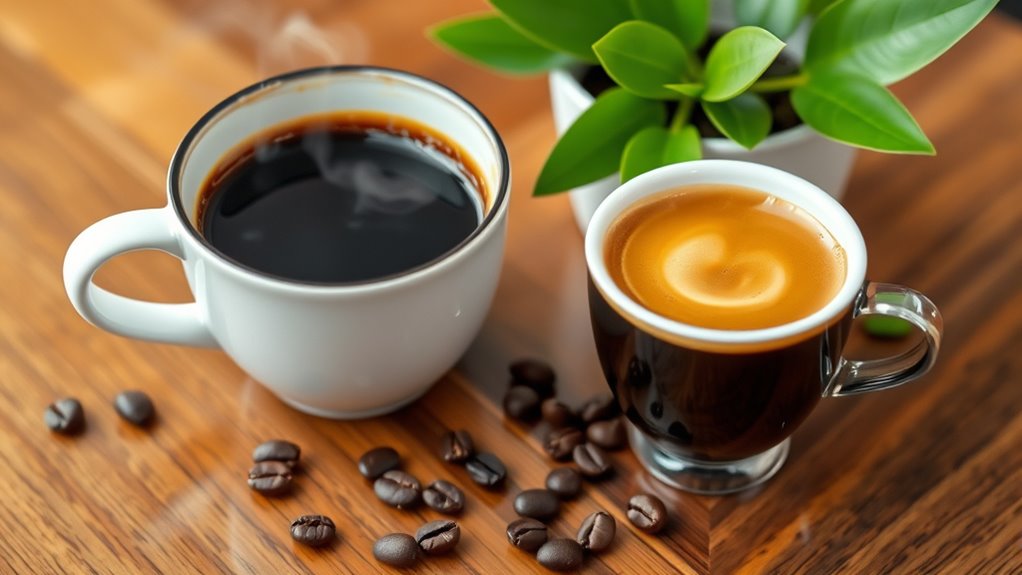
Ever wondered how many ways coffee can surprise you? It’s not just about black coffee or espresso anymore.
With innovative flavors and fun coffee cocktails, you can explore a whole new world! Here are some popular variations to try:
- Honey-infused black coffee for a natural sweet kick.
- Espresso martinis—because who doesn’t love coffee and cocktails?
- Affogato—espresso meets ice cream; it’s dessert magic!
- Black sesame syrup in your black coffee for a nutty twist.
Additionally, you can elevate your experience with the best chocolate coffee that combines rich flavors for an indulgent treat!
Choosing Between Black Coffee and Espresso
When you’re caught in the coffee conundrum of choosing between black coffee and espresso, it can feel like picking a favorite child—each has its own charm!
Think about preference factors like caffeine concentration and flavor. If you want a quick jolt, espresso packs a punch in a tiny shot, while black coffee offers a smoother sip with more caffeine overall.
Plus, consider health impacts: black coffee’s generally healthier, but both are low in calories. For those using a percolator, the choice of best ground coffee can significantly enhance the brewing experience.
